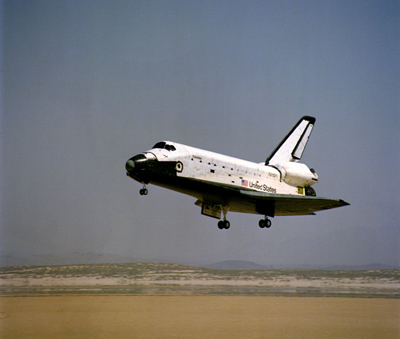By David McBride
Center Director
NASA Dryden Flight Research Center
April 12 is a significant date in space history. On that day in 1961, Soviet Yuri Gagarin became the first person in space. On that same day in 1981, NASA launched space shuttle Columbia on its maiden voyage into space, marking not only America’s return to space but also the first flight of the nation’s new shuttle transportation system. The shuttle was the first – and so far, only – reusable spacecraft, itself an extraordinary accomplishment. Dryden played a major role in the development of this system.
Image: Space shuttle Columbia comes in for the STS-1 landing at Edwards Air Force Base on April 14, 1981.
Yesterday NASA announced the four locations where the existing orbiters will be put on permanent display once the program draws to a close. It may appear to many as though the shuttle’s retirement means an end to American space-faring, but that is a shortsighted perspective. We took a six-year break between the final Apollo mission and the launch of the first shuttle, during which time no American flew in space. NASA’s current focus is on transferring the space launch business to private enterprise, and during that time we will continue to launch Americans into space in cooperation with our Russian partners.
Through all this, Dryden has remained involved in our nation’s space initiative. It was a pattern that was set in the late 1950s with the X-15 program then continued through the 60s and 70s with the Lunar Landing Research Vehicle, lifting bodies, Approach and Landing Tests for the space shuttle, right down through our direct support of the shuttle program as the missions were flown. Our role hasn’t merely been one of support, however; we have been directly involved in aerospace innovation. The first integrated scramjet was demonstrated here, opening new possibilities for access to space, and Dryden plays a central role in the Flight Opportunities Program, which is part of the president’s new plan for NASA. And of course we were the center responsible for testing the Pad Abort system for the Orion Crew Exploration Vehicle. Even now Dryden engineers are at work on new ways to gain access to space, through research on electromagnetic acceleration down a rail and airborne rocket launches into low-Earth orbit.
We are not done perfecting the science of flight. There are many new discoveries waiting to be made through flight research programs. Just as our predecessors united for a common cause, we, too, are looking ahead, developing next-generation aircraft that are more environmentally friendly and systems that will take us to destinations beyond low-Earth orbit.
As the primary backup-landing site for the shuttle program, we stand ready to support the final two missions. While some hope for a landing at Edwards so they can say goodbye to an old friend, I look for the inspiration to be found in all that we’ve accomplished, and the challenges that lie ahead as we do it all over again.
